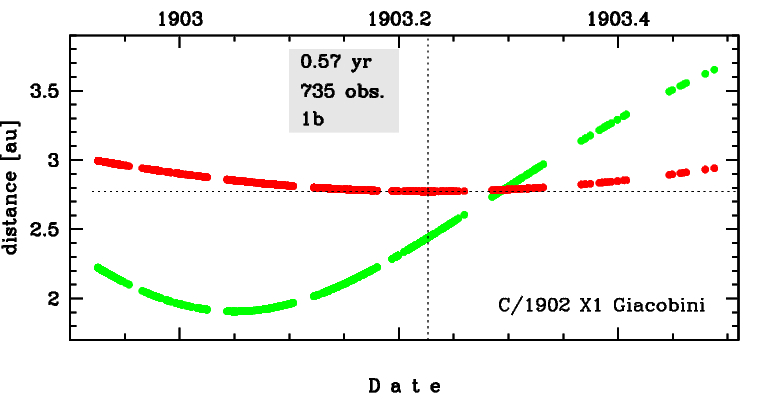C/1902 X1 Giacobini
more info
Comet C/1902 X1 was discovered on 2 December 1902 by Michel Giacobini (Nice Observatory, France), that is almost four months before perihelion passage, and it was last seen on 27 June 1903 [Kronk, Cometography: Volume 3].
This comet made its closest approach to the Earth on 18 January 1903 (1.91 au), that is about seven weeks after its discovery.
Solution given here is based on data spanning over 0.567 yr in a narrow range of heliocentric distances from 3.00 au through perihelion (2.77 au) to 2.94 au.
This Oort spike comet suffers moderate planetary perturbations during its passage through the planetary system that lead to escape the comet from the planetary zone on a hyperbolic orbit (see future barycentric orbit)
More details in Królikowska et al. 2014.
This comet made its closest approach to the Earth on 18 January 1903 (1.91 au), that is about seven weeks after its discovery.
Solution given here is based on data spanning over 0.567 yr in a narrow range of heliocentric distances from 3.00 au through perihelion (2.77 au) to 2.94 au.
This Oort spike comet suffers moderate planetary perturbations during its passage through the planetary system that lead to escape the comet from the planetary zone on a hyperbolic orbit (see future barycentric orbit)
More details in Królikowska et al. 2014.
| solution description | ||
|---|---|---|
| number of observations | 735 | |
| data interval | 1902 12 02 – 1903 06 27 | |
| data type | perihelion within the observation arc (FULL) | |
| data arc selection | entire data set (STD) | |
| range of heliocentric distances | 3 au – 2.77 au (perihelion) – 2.94 au | |
| detectability of NG effects in the comet's motion | NG effects not determinable | |
| type of model of motion | GR - gravitational orbit | |
| data weighting | YES | |
| number of residuals | 1307 | |
| RMS [arcseconds] | 1.66 | |
| orbit quality class | 1b | |
| previous orbit statistics, both Galactic and stellar perturbations were taken into account | ||
|---|---|---|
| no. of returning VCs in the swarm | 5001 | * |
| no. of escaping VCs in the swarm | 0 | |
| no. of hyperbolas among escaping VCs in the swarm | 0 | |
| previous reciprocal semi-major axis [10-6 au-1] | 64.95 – 74.16 – 83.35 | |
| previous perihelion distance [au] | 3.5 – 4.1 – 5 | |
| previous aphelion distance [103 au] | 24 – 27 – 31 | |
| time interval to previous perihelion [Myr] | 1.3 – 1.6 – 1.9 | |
| percentage of VCs with qprev < 10 | 100 | |
| previous_g orbit statistics, here only the Galactic tide has been included | ||
|---|---|---|
| no. of returning VCs in the swarm | 5001 | * |
| no. of escaping VCs in the swarm | 0 | |
| no. of hyperbolas among escaping VCs in the swarm | 0 | |
| previous reciprocal semi-major axis [10-6 au-1] | 64.98 – 74.20 – 83.36 | |
| previous perihelion distance [au] | 3.28 – 3.55 – 4.06 | |
| previous aphelion distance [103 au] | 24 – 27 – 31 | |
| time interval to previous perihelion [Myr] | 1.3 – 1.6 – 1.9 | |
| percentage of VCs with qprev < 10 | 100 | |
